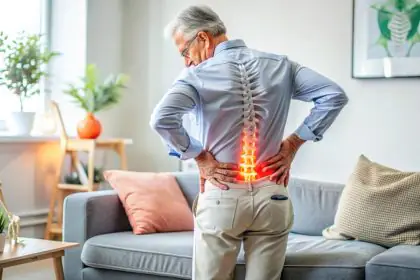Chest pain is one of the most common reasons people visit the emergency room. It can be caused by various conditions, ranging from mild to life-threatening.
Some of the possible causes of chest pain include heart problems, lung problems, digestive problems, muscle strain, anxiety, and more. However, not all chest pain is the same. Some types of pain may indicate a serious medical emergency, such as a heart attack, while others may be harmless or easily treatable. Therefore, it is important to know how to decode your chest pain and recognize the signs that require immediate attention.
In this article, we will discuss the common causes of pain, how to differentiate between heartburn and heart attack symptoms, the risk factors for heart-related chest pain, when to seek emergency care, and some preventive measures and healthy habits to avoid chest pain in the future.
Common Causes of Chest Pain
Chest pain can have many different causes, depending on the location, quality, intensity, duration, and triggers of the pain.
Some of the most common causes of chest pain are:
Heart problems: These include coronary artery disease, angina, heart attack, myocarditis, pericarditis, aortic dissection, and more.
Heart-related chest pain usually occurs in the center or left side of the chest and may radiate to the arm, jaw, neck, back, or abdomen.
It may also be accompanied by shortness of breath, sweating, nausea, vomiting, dizziness, or irregular heartbeat.
Lung problems: These include pneumonia, pleurisy, pulmonary embolism, pneumothorax, asthma, bronchitis, and more.
Lung-related chest pain usually occurs in the upper or lower chest and may worsen with breathing, coughing, or sneezing.
It may also be accompanied by fever, chills, cough, sputum, wheezing, or difficulty breathing.
Digestive problems: These include gastroesophageal reflux disease (GERD), esophagitis, esophageal spasm, peptic ulcer, gallstones, pancreatitis, and more.
Digestive-related chest pain usually occurs in the upper or middle chest and may worsen with eating, drinking, lying down, or bending over.
It may also be accompanied by heartburn, regurgitation, belching, bloating, nausea, vomiting, or abdominal pain.
Musculoskeletal problems: These include costochondritis, rib fracture, muscle strain, arthritis, fibromyalgia, and more.
Musculoskeletal-related chest pain usually occurs in the front or side of the chest and may worsen with movement, posture, or pressure.
It may also be accompanied by tenderness, swelling, redness, or warmth in the affected area.
Psychological problems: These include anxiety, panic attack, depression, stress, and more.
Psychological-related chest pain usually occurs in the center of the chest and may vary in intensity and duration.
It may also be accompanied by palpitations, hyperventilation, trembling, sweating, or fear.
Differentiating Between Heartburn and Heart Attack Symptoms
One of the most common dilemmas that people face when they experience chest pain is whether it is caused by heartburn or a heart attack.
Heartburn is a burning sensation in the chest that occurs when stomach acid backs up into the esophagus.
A heart attack is a life-threatening condition that occurs when the blood flow to the heart muscle is blocked by a clot or plaque in the coronary arteries.
Both heartburn and heart attack can cause chest pain that may be similar in some aspects, such as location, quality, and intensity.
However, there are also some key differences that can help you distinguish between them.
Here are some of the main differences between heartburn and heart attack symptoms:
- Onset: Heartburn usually occurs after eating, drinking, or lying down, especially if you have consumed spicy, fatty, or acidic foods or beverages.
A heart attack can occur at any time, even at rest, but it is more likely to occur during physical activity, emotional stress, or exposure to cold weather.
- Duration: Heartburn usually lasts for a few minutes to a few hours, depending on the severity and treatment of the condition.
A heart attack usually lasts longer than 15 minutes and does not improve with antacids or other medications.
- Associated symptoms: Heartburn usually causes a sour or bitter taste in the mouth, difficulty swallowing, or a feeling of food stuck in the throat.
A heart attack usually causes shortness of breath, sweating, nausea, vomiting, dizziness, or fainting.
- Response to medication: Heartburn usually responds well to antacids, proton pump inhibitors, or H2 blockers, which reduce the production or effect of stomach acid.
A heart attack usually requires emergency treatment with aspirin, nitroglycerin, or clot-busting drugs, which restore the blood flow to the heart muscle.
Risk Factors for Heart-Related Chest Pain
Heart-related chest pain is one of the most serious and potentially fatal causes of chest pain.
Therefore, it is important to know the risk factors that increase the likelihood of developing heart problems that can cause chest pain.
Some of the major risk factors for heart-related chest pain are:
- Age: The risk of heart-related chest pain increases with age, especially after 45 years for men and 55 years for women.
- Gender: Men are more likely to experience heart-related chest pain than women, although the gap narrows after menopause.
- Family history: Having a close relative who had a heart attack or other heart problems before 55 years for men and 65 years for women increases the risk of heart-related chest pain.
- Smoking: Smoking damages the lining of the blood vessels, increases the blood pressure and heart rate, and reduces the oxygen supply to the heart.
Smoking also increases the risk of blood clots that can block the coronary arteries.
- High blood pressure: High blood pressure puts extra strain on the heart and damages the arteries, making them more prone to narrowing and hardening.
High blood pressure also increases the risk of aortic dissection, which is a tear in the inner layer of the aorta that can cause severe chest pain.
- High cholesterol: High cholesterol leads to the buildup of plaque in the arteries, which reduces the blood flow to the heart and increases the risk of angina and heart attack.
High cholesterol also increases the risk of aortic aneurysm, which is a bulge in the wall of the aorta that can rupture and cause severe chest pain.
- Diabetes: Diabetes affects the ability of the body to use glucose, which is the main source of energy for the heart.
Diabetes also damages the nerves and blood vessels, making them more susceptible to inflammation and infection.
Diabetes also increases the risk of coronary artery disease, angina, and heart attack.
- Obesity: Obesity increases the workload of the heart and the demand for oxygen.
Obesity also increases the risk of high blood pressure, high cholesterol, diabetes, and sleep apnea, which are all risk factors for heart-related chest pain.
- Physical inactivity: Physical inactivity weakens the heart muscle and reduces its efficiency.
Physical inactivity also increases the risk of obesity, high blood pressure, high cholesterol, and diabetes, which are all risk factors for heart-related chest pain.
- Stress: Stress triggers the release of hormones that increase the blood pressure and heart rate, and constrict the blood vessels.
Stress also increases the risk of anxiety, depression, and panic attacks, which can cause chest pain.
Stress also increases the risk of unhealthy behaviors, such as smoking, drinking, overeating, and skipping medications, which can worsen the risk factors for heart-related chest pain.
When to Seek Emergency Care
Chest pain can be a sign of a serious medical emergency that requires immediate attention.
If you experience any of the following symptoms, you should call 911 or your local emergency number right away:
- Pain that is sudden, severe, crushing, squeezing, or pressure-like, and lasts more than 15 minutes or does not improve with rest or medication.
- Pain that spreads to the arm, jaw, neck, back, or abdomen, or is accompanied by shortness of breath, sweating, nausea, vomiting, dizziness, or fainting.
- Pain that occurs with a high fever, chills, cough, sputum, or difficulty breathing, especially if you have a history of lung problems or a weakened immune system.
- Pain that occurs with a sudden sharp or tearing sensation in the chest, back, or abdomen, or is accompanied by a difference in blood pressure or pulse between the arms, or a pulsating mass in the abdomen, especially if you have a history of high blood pressure or aortic problems.
- Pain that occurs with a history of heart problems, such as coronary artery disease, angina, heart attack, or heart failure, or with risk factors for heart problems, such as age, gender, family history, smoking, high blood pressure, high cholesterol, diabetes, obesity, physical inactivity, or stress.
Preventive Measures and Healthy Habits
Chest pain can be prevented or reduced by adopting some preventive measures and healthy habits that can lower the risk of developing the underlying conditions that can cause chest pain.
Some of the preventive measures and healthy habits that can help you avoid chest pain are:
- Quit smoking or avoid exposure to secondhand smoke, which can damage your heart and lungs and increase your risk of chest pain.
- Maintain a healthy weight and a balanced diet, which can lower your blood pressure, cholesterol, and blood sugar levels and prevent obesity and diabetes, which are risk factors for chest pain.
- Exercise regularly and moderately, which can strengthen your heart and lungs and improve your blood circulation and oxygen supply.
Aim for at least 150 minutes of moderate-intensity aerobic activity or 75 minutes of vigorous-intensity aerobic activity per week, or a combination of both.
Try to relax, meditate, breathe deeply, or do other activities that can calm you down and reduce your anxiety and depression.
- Follow your doctor’s advice and take your medications as prescribed, which can help you control your underlying conditions that can cause chest pain, such as heart problems, lung problems, or digestive problems.
Do not stop or change your medications without consulting your doctor.
- Monitor your symptoms and seek medical attention when needed, which can help you prevent complications and get timely treatment for your chest pain.
Do not ignore or delay seeking help if you experience any signs of a serious medical emergency, such as a heart attack, a pulmonary embolism, or an aortic dissection.
Conclusion
Pain is a common symptom that can have many different causes, some of which can be serious and life-threatening.
Therefore, it is important to know how to decode your chest pain and recognize the signs that require immediate attention.
It is also important to know the risk factors for heart-related chest pain and adopt some preventive measures and healthy habits that can lower your risk of developing chest pain in the future.
By doing so, you can protect your health and well-being and enjoy a better quality of life.
FAQs
What are the common causes of chest pain?
It can be caused by various factors, including indigestion, muscle strain, respiratory issues, or more serious conditions like heart problems.
Identifying the underlying cause is crucial for appropriate management.
How can I differentiate between heartburn and a heart attack?
While heartburn and heart attack can share some symptoms, such as chest discomfort, heart attack symptoms often include radiating pain to the arm, jaw, or back, along with shortness of breath. If in doubt, seek immediate medical attention.
Are there specific risk factors for heart-related chest pain?
Yes, several risk factors contribute to heart-related chest pain, including a sedentary lifestyle, poor diet, smoking, hypertension, diabetes, and a family history of heart disease.
Managing these risk factors is crucial for heart health.
When should I seek emergency care for chest pain?
Seek emergency care if you experience intense, crushing chest pain, especially if it radiates to the arm or jaw, is accompanied by shortness of breath, nausea, or lightheadedness.
Don’t ignore persistent or severe chest pain.
Can chest pain be a symptom of conditions other than heart issues?
Absolutely. Pain can result from various conditions like anxiety, pneumonia, rib injuries, or gastrointestinal problems.
It’s important to consider the full context of symptoms and seek medical advice for an accurate diagnosis.
What preventive measures can I take to reduce the risk of chest pain?
Adopting a heart-healthy lifestyle is key.
This includes regular exercise, maintaining a balanced diet, avoiding smoking, managing stress, and attending regular check-ups to monitor and address any potential risk factors.





